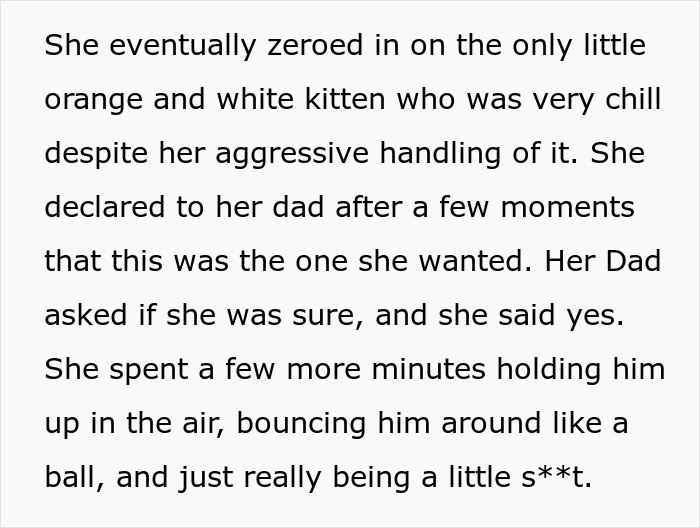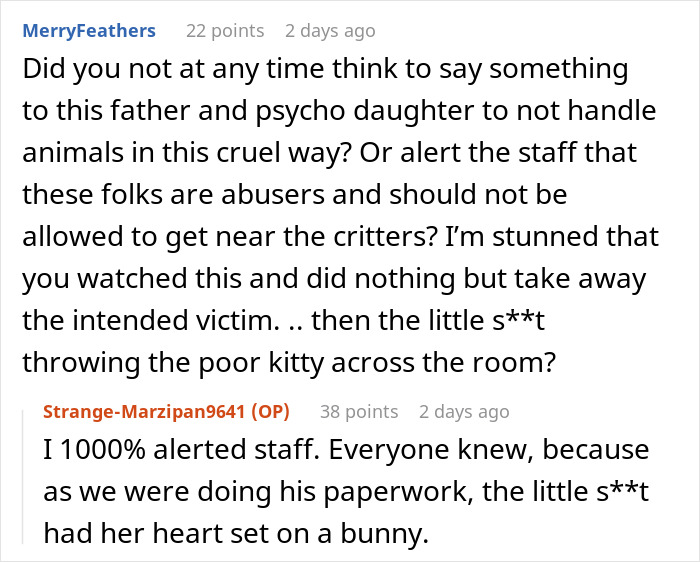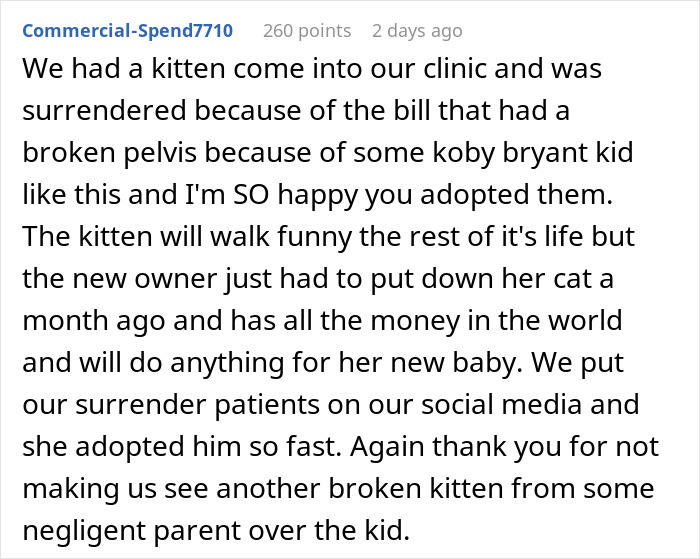
Girl Loses It When Woman Adopts A Cat She Wanted At The Shelter As Punishment For Torturing It
Interview With ExpertMany adults fondly look back at the memories they had with their childhood pets. From crawling together in the mud to confiding the deepest, darkest secrets to each other, children and pets might seem like a match made in heaven. However, interacting with furry friends doesn’t always come naturally to little ones and it’s the parents’ responsibility to teach them kindness and respect towards animals.
Unfortunately, this parent was unsuccessful in instilling this in his daughter. When they visited a rescue shelter hoping to adopt a kitten, the child aggressively handled the poor creatures, smacking and throwing them around. While the father stood and did nothing, luckily, a woman was watching the whole time and swiftly devised an intervention plan so no animal ended up in the wrong hands.
Scroll down to find the full story and conversation with Dr. LaShelle Easton, holistic veterinarian, animal communicator, and author, and Dr. Dawn Filos, veterinarian, blogger, and author of Tales of a Pet Vet: Stories from the Clinic and House Calls, who kindly agreed to tell us more about the importance of teaching kids how to properly act towards animals.
It’s parents’ responsibility to teach their children to be kind and respectful towards animals
Image credits: Peng Louis (not the actual photo)
Unfortunately, this father let his daughter smack and throw around kittens in a rescue shelter without a word
Image credits: bondarillia (not the actual photo)
Image credits: natee127 (not the actual photo)
Image credits: Strange-Marzipan9641
Parents should start teaching their kids to be kind to pets as soon as they show any interest in animals
Pets play a significant role in children’s lives. They help them socialize, care for, and nurture others. This is especially beneficial when children don’t have siblings to learn from and play with, as these skills are vital in a child’s development. Funny enough, 50% of children admit to talking to their pets, one in three reveal their secrets to them, and more than a third believe that animals in their home understand how they feel. This shows just how important children’s and pets’ bond really is.
But while many children have a natural love for animals, some little ones can display concerning behavior towards animals simply because they lack understanding. Therefore, Dr. LaShelle Easton, holistic veterinarian, animal communicator, and author, recommends parents start teaching their children to be kind to pets as soon as they show any interest in animals, whether that’s in a picture book or person.
“There is no such thing as “too young” when it comes to teaching kids how to be kind to animals. Also, children—especially younger children—should always be supervised when around animals, to protect both the children and the pets!” says Easton.
It’s important to teach kids how to respectfully act around furry companions, as learning to interpret their needs and feelings helps to develop empathy. “It also keeps both animals and children safe—children often engage in behaviors that make animals uncomfortable, and that might cause the animals to react by scratching, biting, or worse,” she adds. “In the majority of “cute” videos I see on the Internet that feature children interacting with animals, the animals are making it very clear through their body language that they are very uncomfortable with the interaction. It’s amazing we don’t see more injuries!”
Meanwhile, veterinarian Dr. Dawn Filos says, “Living with pets teaches kids responsibility, and developing a healthy relationship with animals, particularly early on, gives them ease around animals and a familiarity that will not only help them recognize a friendly pet but an unfriendly or fearful animal. It teaches them the value of unconditional, non-judgemental love.
They also become more aware of the boundaries of others, being taught by the body language of animals as they interact with them and get feedback from them as they unconsciously learn what is acceptable and what is not.”
Children can be taught to treat animals kindly by modeling the correct behavior
Image credits: Pixabay (not the actual photo)
Parents can teach children to treat animals kindly by modeling the correct behavior, says Easton. “Reading books about animals and learning about animals in places like zoos or nature centers also helps children learn to treat animals with kindness. Having a pet can also be a wonderful experience for children, but you should only bring a pet into your family if you are prepared to care for it both emotionally and financially—that part can’t be left up to your children.”
Filos says that the worrisome actions parents should look out for are kids roughhousing, poking, pulling tails, wrestling, or messing with pet food.
If parents notice that their kid is exhibiting concerning behavior towards an animal, they need to immediately intervene. “That may mean showing the child the correct behavior, or it may mean separating the child from the animal entirely. Animals will defend themselves when they feel threatened, and it’s important that parents help keep both the children and the animals safe,” explains Eaton.
“Dogs, cats, or other pets should not be expected to tolerate anything that a child does to them, such as chasing them or pulling their tails,” says Filos. “All play between children and pets should be structured, supervised, and contain predictable interactions. It is important to learn and teach children how to read body language to determine if a pet is stressed or anxious. Yawning and avoiding eye contact are common cues to look out for. If seen, separate the pet and child and start again later, avoiding the triggers that set the pet off in the past.”
As a final note, the holistic vet stresses the importance of this, as missing the warning signs of a pet being uncomfortable with children’s behavior can be incredibly dangerous and lead to injuries. “Dog bites are one of the leading causes of emergency room visits in kids and in toddlers, those bites are most often to the head or face.”
The author also kindly shared photos of Otis on his freedom ride
Image credits: Strange-Marzipan9641
Image credits: Strange-Marzipan9641
Readers were glad that the woman was able to save the kitten from ending up in the wrong hands
Poll Question
Thanks! Check out the results:
107Kviews
Share on FacebookExplore more of these tags
I lie the Wall of Shame idea for a*****e who mistreat animals and children. Except for kids like that little s**t. She goes on the wall—-with a big picture of her little fuckface, which will be put at the very TOP!!
How did FUCKFACE get missed! BP dropping the ball.
Load More Replies...Bless the OP for rescuing this little baby floof. It hurts my heart when animals are mistreated or hurt.
I lie the Wall of Shame idea for a*****e who mistreat animals and children. Except for kids like that little s**t. She goes on the wall—-with a big picture of her little fuckface, which will be put at the very TOP!!
How did FUCKFACE get missed! BP dropping the ball.
Load More Replies...Bless the OP for rescuing this little baby floof. It hurts my heart when animals are mistreated or hurt.

 Dark Mode
Dark Mode 

 No fees, cancel anytime
No fees, cancel anytime 













































































57
57